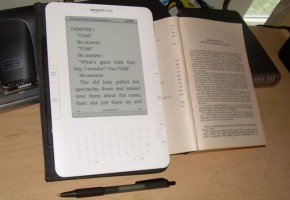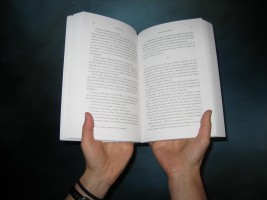The post This is how I became an author – Part III appeared first on Thomas McGann.
]]>As mentioned in the last post, I had hoped to finish this recap of the series “So you want to become an author…” in two parts but there was still so much more to tell that I needed to include Part III of “This is how I became an author.”
My book had been published both as a Kindle eBook (KDP) and as a paperback with CreateSpace (CS), but if I expected it to be available to all readers, I needed to consider the other platforms out there that Amazon did not cover – Barnes and Noble, Kobo, Apple, and others. That meant that I had to find another publisher/distributor that catered to those markets.
Two of the major players are Smashwords(SW) and Draft2Digital (D2D). Arguments for both held some sway, but I decided on SW, because it promised to cover all devices, and all screen sizes. Alas, this required yet another go at formatting, and this one was as intense as KDP. Therefore, it was nose-to-the-grindstone once again, and, finally, after overcoming some SW shortcomings, I was able to publish on the remaining platforms – though it did take some weeks for the process to be completed.
Interspersed with all of the above, some other discussions needed attention.
- Rejection was one of those topics – about how much rejection sucks. We all go through it, and it does suck, but we soldier on.
- Another issue was copyright. When I got serious about publishing, I realized that I had to change the title of my work. I did this strictly for marketing purposes. I had copyrighted my manuscript years ago, but the title change meant that I may or may not need to protect that new title. Consequently, I had to learn about the intricacies of copyright law. Did a title change require an addendum to the original copyright? The answer was ambiguous, but I decided to err on the side of safety, and I sent in the necessary paperwork – and check. Read the post “To copyright or not to copyright” for horror stories of what can happen if you do not register your copyright. Is a registered copyright really necessary? The answer is that it is not, but it is HIGHLY recommended. (See the referenced post.)
- A personal concern was that I decided to use a different font just for the title. This meant more lessons in finding, using, and, particularly, embedding fonts (see Part II of this 3 part recap for problems I encountered with the embedding process.)
These detours offered some relief by breaking up the unrelenting formatting procedures. I might have chosen to disregard these issues, but they were important enough to me to address. Besides, looking into copyright issues relieved some piracy concerns (see the “Jack Sparrow be damned” post), and embedding the new font provided a welcomed funky new look for the book title.
Another sidebar bears mentioning here. It is the blog post entitled “On Creativity”, and it was sparked by an essay Isaac Asimov wrote called “How do people get new ideas?” I urge all artists to read Asimov’s ideas. Creativity is a shy, elusive creature. Down uncounted burrows we search – and, sometimes, we find.
After completing all of the above, I was now a published author, with eBooks available on all devices, and a paperback from Amazon of which I am righteously proud. The links to these various editions are on the sidebar of this post, just beneath the image of the book cover.
The steps outlined in the three parts of this post are how I became an author. I hope these explanations help you accomplish your goals, and you too become the author you always dreamed of becoming.
Now, finally, we get a chance to rest on our laurels.
No way! Getting published was the EASY PART. Now comes marketing. So far, the only one who knows about your book is you – and the few friends and relatives you’ve informed.
How do you tell the rest of the world?
Marketing, that’s how.
Marketing is a whole new world unto itself. There are scholars with PhDs whose lives are dedicated to nothing but marketing, and now we have to tackle that too. Ugg!
DO NOT DISPAIR! We can do this and we will.
This post ends the series “So you want to be an author…” I have already started my marketing plan, so the next series will follow that plan step by step just as this series followed getting published. Stay tuned.![]()
The post This is how I became an author – Part III appeared first on Thomas McGann.
]]>The post This is how I became an author – Part II appeared first on Thomas McGann.
]]>We left off “This is how I became an author…” last time with the understanding that the hard work, the formatting, lay ahead. This step by step explanation of my process will sometimes include the titles of the posts that contain more in depth details if you want to go back to learn more.
The manuscript was finished. It had been copy edited and proofread. It was now ready to be published, and I would become an author.
I am unsure whether publishing a paperback or an eBook first would have made a difference, but I choose to publish the eBook. I decided to use Amazon because of its dominance in the marketplace, and because its eBook reader, Kindle, is one of the more popular electronic reading platforms. This required a Kindle (KDP) format.
- Research indicated that the “nuclear option” should be the first step in producing a clean professional product. A quick review of that post on my blog outlines the steps involved, and provides links for more extensive explanations of what is involved. Using the nuclear option is a big deal. It is not mind-boggling. It just involves numerous steps.
- My manuscript contains six images. The use of images introduces a whole other level of complexity. Images may have to be manipulated, cropped, rotated, flipped, etc, and they need a resolution of 300 dpi to meet KDP requirements. This was a multistep, complicated process. I used GIMP for this, a free program similar to Photoshop.
- Somewhere along the way, I learned about the Snipping Tool, and that was an invaluable find.
- When it came time to upload my manuscript onto Kindle, I discovered that some of the information I was reading was wrong. In order to upload files to Kindle you need zip files. The procedures outlined were incorrect. Eventually, by trial and error, I was able to figure out the correct method (see post), using separate zip files for both the text and the images.
That did it and, voila, I was published, albeit in an eBook, but published nonetheless.
Next step – publish the paperback.
After the difficulties formatting the eBook, I thought the process for the paperback would be a cakewalk. After all, what you see, is what you get, right? Not so fast.
- First, the physical properties of the book need to be specified: the size of the book (I choose 6×9), paper color, cover finish, margins/gutter, bleed, etc. The size change, in particular, and the margin delineations alter the structure of the book. With fewer words on a page, more pages are created, and the chapters begin and end on different pages than they did on the usual 8 ½ 11 display. This also changes chapter endings so I needed to watch for widows or orphans.
- While the formatting for a paperback is simpler, sometimes MS Word decides to misbehave. I encountered poltergeists. I could hear them giggling quietly as they scrambled my pagination, and inserted blank pages where none were desired. A shout-out to fellow writers on LinkedIn provided the necessary fumigation solution (see post). I still believe poltergeists inhabit MS Word.
- My manuscript was now ready to be uploaded to CreateSpace (CS), Amazon’s paperback publishing wing. Once again, the procedure was supposed to be simple, but now I got a case of the hiccups – embedded font and image resolution hiccups. The CS Interior Reviewer (IR) indicated that these hiccups were errors. I chanced that they were not, and published anyway. I purchased a proof ($5) just to make sure that the book read properly, was free of typos, and then I waited.
The galley proof came about a week later (“My book galley is here”). The hiccups were not errors. I had been right. The IR failed to recognize that the font had been embedded properly, and that the image resolutions were, in fact, 300 dpi.
However, the proof was not perfect. I had introduced errors into my pristine manuscript during my preparations for publication that necessitated tweaking (“Let it be”). I made those corrections and sent for another proof. It contained a stupid mistake (a table of contents, TOC, problem caused by the change in book size mentioned above). I made the TOC corrections, ordered another proof, and waited once again.
Finally, my paperback arrived. Yea! This time it was “perfect,” and I could hold it in my hand and I did. Now I really was an author.
An aside here: Our manuscripts are never perfect. There are posting after posting about the recurring problem of typos, even after numerous editings and proofreadings – even by professionals. Each fresh edition eliminates a few more.
I thought I would be able to finish this summary in just two parts, but it has become obvious that is not possible without this post becoming way too long. I’ll have to finish up in the next time. Stay tuned.![]()
The post This is how I became an author – Part II appeared first on Thomas McGann.
]]>
